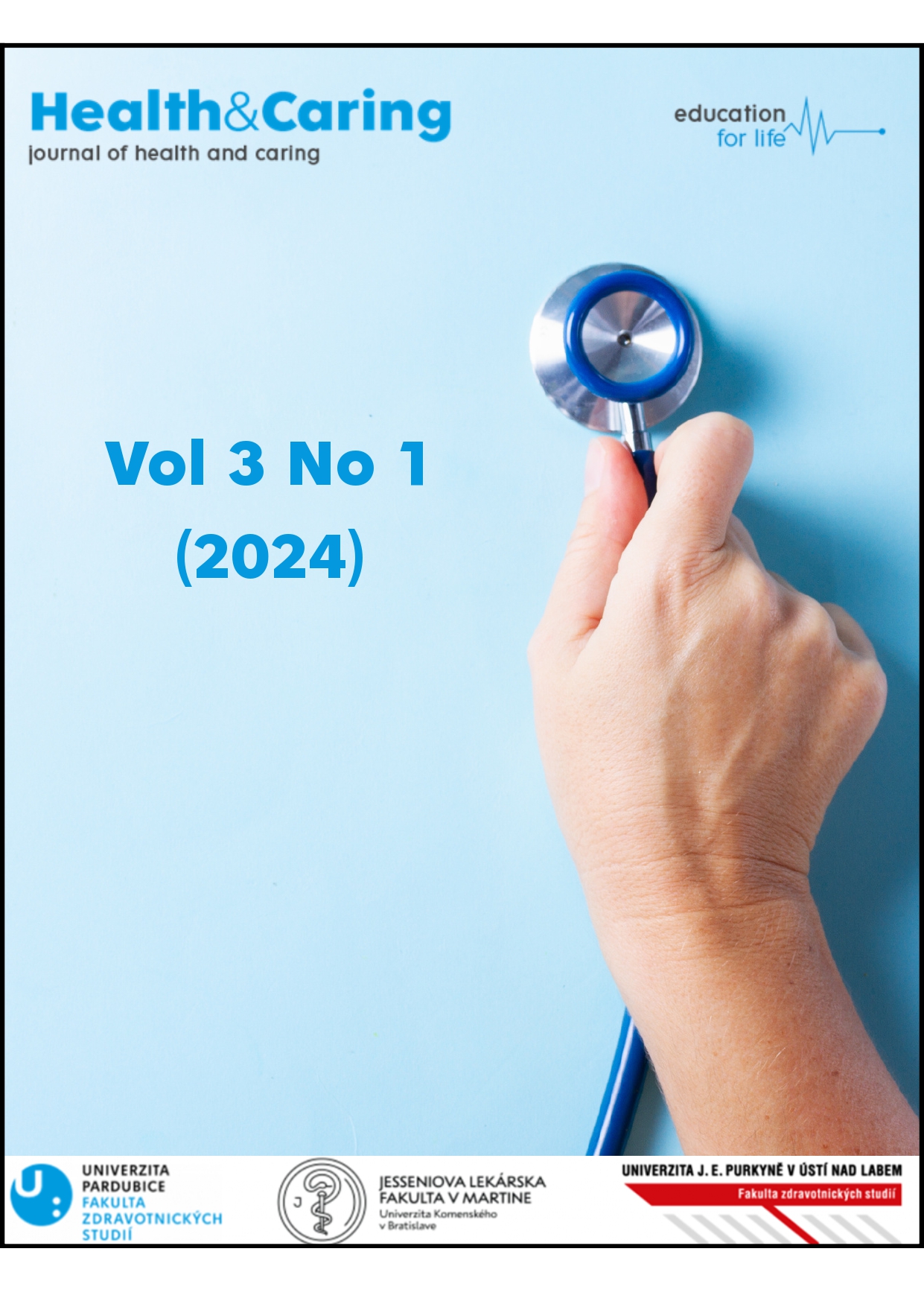Aggressive Patient in Healthcare Facility – Experience of a Selected Sample of Nurses in the Czech Republic: Descriptive, Cross-Sectional Study
DOI:
https://doi.org/10.46585/hc.2024.1.2497Klíčová slova:
aggressive patient, healthcare, nurse, nursingAbstrakt
Aim: To identify and describe the experience of a selected sample of nurses with aggressive behaviour by patients and their family members. To describe what nurses rate as the most common causes of aggression and what strategies nurses most commonly use to manage it. To determine whether there is a statistically significant association between the incidence of aggressive behaviour and length of practice in the selected sample of nurses.
Methods: This study included a group of nurses from a selected healthcare facility, totalling 67 nurses. A self-constructed questionnaire was used. The data were processed in STATISTICA 12 software using descriptive statistics and Spearman's correlation coefficient. This study complied with the EQUATOR (STROBE) checklist.
Results: More than 70% of the nurses in our study had experienced aggressive behaviour by a patient. Nurses are most often exposed to verbal aggression, especially swearing and insults. Less frequently, they encounter physical assault. Most often, it is the patients who are aggressive; patients’ families or visitors are rarely aggressive. To manage aggressive behaviour, nurses most often use calm, assertive communication. In the selected sample of nurses, there was no significant association between the incidence of aggressive behaviour and length of nursing experience.
Conclusions: Our results show that most of the nurses in the selected sample have negative experiences with aggressive behaviour. Knowledge of assertive communication can significantly contribute to minimising conflicts associated with aggressive behaviours in patients. The research conducted may serve as a basis for further research.
Stažení
Reference
AP ASSOCIATION, et al. (2013). Diagnostic and statistical manual of mental disorders: diagnostic and statistical manual of mental disorders.
Ashton R. A., Morris L., & Smith I. A. (2018). Qualitative meta-synthesis of emergency department staff experiences of violence and aggression. International emergency nursing, 39, 13–19. https://doi.org/10.1016/j.ienj.2017.12.004
Ayhan, D., Mercan, N., Doğan R., & Yüksel Ç. (2021). The aggressive patient experiences of healthcare professionals exposed to physical violence in a psychiatric clinic: A phenomenological study. Perspectives in psychiatric care, 1–8. https://doi.org/10.1111/ppc.12918
Chatzigianni, D., Tsounis, A., Markopoulos, N., & Sarafis, P. (2018). Occupational stress experienced by nurses working in a Greek Regional Hospital: A cross-sectional study. Iranian journal of nursing and midwifery research, 23(6), 450–457. https://dx.doi.org/10.4103/ijnmr.IJNMR_120_17
Cooper, A. L., Brown, J. A., Rees, C. S., & Leslie, G. D. (2020). Nurse resilience: A concept analysis. International journal of mental health nursing, 29(4), 553-575. https://doi.org/10.1111/inm.12721
Dafny, H.A., & Beccaria, G. (2020). I do not even tell my partner: Nurses’ perceptions of verbal and physical violence against nurses working in a regional hospital. Journal of clinical nursing, 29(17-18), 3336–3348. https://doi.org/10.1111/jocn.15362
El-Bardi, S.M., & Mellsop, G. (2006). Aggressive behaviour in an acute general adult psychiatric unit. Psychiatric Bulletin, 30(5), 166–168. https://doi.org/10.1192/pb.30.5.166
Grassi, L., Biancosino, B., Marmai, L., Kotrotsiou, V., Zanchi, P., Peron, L., Marangoni, C., Vanni, A., & Barbui, C. (2006). Violence in psychiatric units. Social Psychiatry and Psychiatric Epidemiology, 41(9), 698–703. https://doi.org/10.1007/s00127-006-0088-5
Gu, B., Tan, Q., & Zhao, S. (2019). The association between occupational stress and psychosomatic wellbeing among Chinese nurses: A cross-sectional survey. Medicine, 98(22), e15836. https://doi.org/10.1097/MD.0000000000015836
Homotoff, K. (2021). Defusing aggressive behavior in the healthcare setting. Journal of the American Academy of Pas., 34(9), 46–49. https://doi.org/10.1097/01.JAA.0000758216.65209.27
Kaeser, D., Guerra, R., Keidar, O., Lanz, U., Moses, M., Kobel, C., Exadaktylos, A. K., & Ricklin, M. E. (2018). Verbal and non-verbal aggression in a Swiss university emergency room: a descriptive study. International journal of environmental research and public health, 15(7): 1423–1430. https://doi.org/10.3390/ijerph15071423
Kołodziej, K., Lickiewicz, J., Jelonek, E., Mlocek, M., Murzyn, M., & Dudek, M. (2021). Psychiatric nurses’ experiences of patient aggression. Pielegniarstwo XXI wieku/Nursing in the 21st Century, 20(3), 160–167. https://doi.org/10.2478/pielxxiw-2021-0021
Partridge, B., & Affleck, J. (2018). Predicting aggressive patient behaviour in a hospital emergency department: an empirical study of security officers using the Brøset violence checklist. Australasian emergency care, 21(1), 31–35. https://doi.org/10.1016/j.auec.2017.11.001
Pelto-Piri, V., Warg, L. E., & Kjellin L. (2020). Violence and aggression in psychiatric inpatient care in Sweden: a critical incident technique analysis of staff descriptions. BMC health services research, 20(1), 1–11. https://doi.org./10.1186/s12913-020-05239-w
Royal College of Nursing. (2018). Violence and aggression in the NHS: Estimating the size and the impact of the problem – an interim report. https://www.rcn.org.uk/-/media/royal-college-of-nursing/documents/publications/2018/october/pdf-007301.pdf
Schablon, A., Wendeler, D., Kozak, A., Nienhaus, A., & Steinke, S. (2018). Prevalence and consequences of aggression and violence towards nursing and care staff in Germany—A survey. International journal of environmental research and public health, 15(6), 1274–1292. https://doi.org/10.3390/ijerph15061274
Song J., A., & Oh, Y. (2015). The association between the burden on formal caregivers and behavioral and psychological symptoms of dementia (BPSD) in Korean elderly in nursing homes. Archives of Psychiatric Nursing, 29(5), 346–354. https://doi.org/10.1016/j.apnu.2015.06.004
Stutte, K., Hahn, S., Fierz, K., & Zúñiga, F. (2017). Factors associated with aggressive behavior between residents and staff in nursing homes. Geriatric nursing, 38(5), 398–405. https://doi.org/10.1016/j.gerinurse.2017.02.001
Ulrich, R. S., Bogren, L., Gardiner, S. K, & Lundin, S. (2018). Psychiatric ward design can reduce aggressive behavior. Journal of Environmental Psychology, 57, 53–66. https://doi.org/10.1016/j.jenvp.2018.05.002
WHO, Framework guidelines for addressing workplace violence in the health sector / Joint Programme on Workplace Violence in the Health Sector [cited 12/20/2021] https://apps.who.int/iris/handle/10665/42617
Yang, B. X., Stone, T.E., Petrini, M.A., & Morris, D. L. (2018). Incidence, type, related factors, and effect of workplace violence on mental health nurses: a cross-sectional survey. Archives of psychiatric nursing, 32(1), 31–38. https://doi.org/10.1016/j.apnu.2017.09.013
Stahování
Publikováno
Jak citovat
Číslo
Sekce
Licence
Copyright (c) 2024 Klára Václavíková

Tato práce je licencována pod Mezinárodní licencí Creative Commons Attribution-NonCommercial 4.0.
Přijat 2024-06-14
Publikován 2024-06-27










